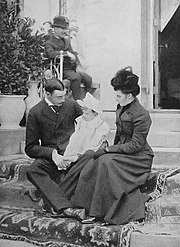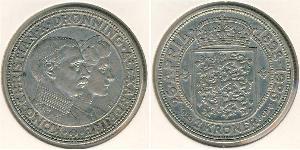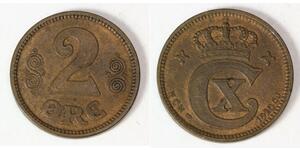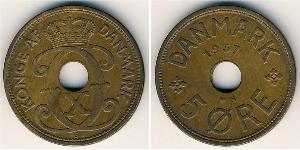| Christian X of Denmark | |
|---|---|
 |
|
| King of Denmark (more...) | |
| Reign | 14 May 1912 – 20 April 1947 |
| Predecessor | Frederick VIII |
| Successor | Frederick IX |
| Prime Ministers | |
| King of Iceland | |
| Reign | 1 December 1918 – 17 June 1944 |
| Prime Ministers | |
| Consort | Alexandrine of Mecklenburg-Schwerin |
| Issue | Frederick IX of Denmark Knud, Hereditary Prince of Denmark |
| House | House of Schleswig-Holstein-Sonderburg-Glücksburg |
| Father | Frederick VIII of Denmark |
| Mother | Louise of Sweden |
| Born | 26 September 1870 Charlottenlund Palace |
| Died | 20 April 1947 (aged 76) Amalienborg Palace |
| Burial | Roskilde Cathedral |
| Religion | Lutheranism |
Christian X (Christian Carl Frederik Albert Alexander Vilhelm; 26 September 1870 – 20 April 1947) was the King of Denmark from 1912 to 1947 and the only king of Iceland (where the name was officially spelled Kristján), between 1918 and 1944.
He was the third Danish monarch of the House of Glücksburg and the first member of his family since king Frederick VII to have actually been born into the Danish royal family; both his father and his grandfather were born as princes of a German ducal family. Among his siblings was King Haakon VII of Norway.
His character as a ruler has been described as authoritarian, and he strongly stressed the importance of royal dignity and power, in spite of the growing importance of democracy.[citation needed] His reluctance to embrace democracy resulted in the Easter Crisis of 1920, in which he dismissed the democratically elected cabinet with which he disagreed, and instated one of his own choosing. This was nominally his right in accordance with the constitution, but facing the risk of the monarchy being overthrown he was forced to accept democratic control of the state and the role as a nominal constitutional monarch.
In spite of becoming unpopular due to his resistance to democracy, during the German Occupation of Denmark he did become a popular symbol of resistance to German occupation, particularly because of the symbolic value of the fact that he rode every day through the streets of Copenhagen unaccompanied by guards. He also became the subject of a persistent urban legend according to which, during Nazi occupation, he donned the Star of David in solidarity with the Danish Jews. This is not true, as Danish Jews were not forced to wear the Star of David. However, the legend likely stems from a 1942 British report that claimed he threatened to don the star if this was forced upon Danish Jews.[1] This is also supported by the king's personal diary, where the following entry can be found:[2]
When you look at the inhumane treatment of Jews, not only in Germany but occupied countries as well, you start worrying that such a demand might also be put on us, but we must clearly refuse such this due to their protection under the Danish constitution. I stated that I could not meet such a demand towards Danish citizens. If such a demand is made, we would best meet it by all wearing the Star of David.
In addition, he helped finance the transport of Danish Jews to unoccupied Sweden, where they would be safe from Nazi persecution.[3]
With a reign spanning two world wars, and his role as a rallying symbol for Danish national sentiment during the German Occupation, he has become one of the most popular Danish monarchs of modern times.
Contents
Early life[edit]

Christian was born on 26 September 1870 at Charlottenlund Palace in Gentofte Municipality near Copenhagen as the oldest son and child of Crown Prince Frederick of Denmark and his wife Louise of Sweden, only surviving child of King Charles XV of Sweden. He was baptised in the Chapel of Christiansborg Palace on 31 October 1870 by the Bishop of Zealand, Hans Lassen Martensen.
Marriage[edit]
Christian married Alexandrine of Mecklenburg-Schwerin in Cannes on April 26, 1898; she was a daughter of Frederick Francis III, Grand Duke of Mecklenburg-Schwerin, and Grand Duchess Anastasia Mikhailovna of Russia. She eventually became his queen consort. They had two children:
- Prince Frederick (1899–1972), later King Frederick IX of Denmark
- Prince Knud (1900–1976), later Knud, Hereditary Prince of Denmark
The couple were given Christian VIII's Palace at Amalienborg Palace in Copenhagen as their residence and Sorgenfri Palace north of Copenhagen as a summer residence. Furthermore, the couple received Marselisborg Palace in Aarhus as a wedding present from the people of Denmark in 1898. In 1914, the King also built the villa Klitgården in Skagen.
Accession[edit]
On 14 May 1912, King Frederick VIII died after collapsing from shortness of breath whilst taking a walk in a park in Hamburg, Germany. He had been returning from a recuperation stay in Nice, France, and was staying anonymously in the city before continuing to Copenhagen. Christian was in Copenhagen when he heard about his father's demise and ascended the throne as Christian X.
Easter Crisis of 1920[edit]

In April 1920, Christian instigated the Easter Crisis, perhaps the most decisive event in the evolution of the Danish monarchy in the Twentieth Century. The immediate cause was a conflict between the King and the cabinet over the reunification with Denmark of Schleswig, a former Danish fiefdom, which had been lost to Prussia during the Second War of Schleswig. Danish claims to the region persisted to the end of World War I, at which time the defeat of the Germans made it possible to resolve the dispute. According to the terms of the Treaty of Versailles, the disposition of Schleswig was to be determined by two plebiscites: one in Northern Schleswig (Denmark's South Jutland County 1971–2006), the other in Central Schleswig (today part of the German state of Schleswig-Holstein). No plebiscite was planned for Southern Schleswig, as it was dominated by an ethnic German majority and, in accordance with prevailing sentiment of the times, remained part of the post-war German state.
In Northern Schleswig, seventy-five percent voted for reunification with Denmark and twenty-five percent for remaining with Germany. In this vote, the entire region was considered to be an indivisible unit, and the entire region was awarded to Denmark. In Central Schleswig, the situation was reversed with eighty percent voting for Germany and twenty percent for Denmark. In this vote, each municipality decided its own future, and German majorities prevailed everywhere. In light of these results, the government of Prime Minister Carl Theodor Zahle determined that reunification with Northern Schleswig could go forward, while Central Schleswig would remain under German control.
Many Danish nationalists felt that at least the city of Flensburg, in Central Schleswig, should be returned to Denmark regardless of the plebiscite's results, due to the sizeable Danish minority there and a general desire to see Germany permanently weakened in the future. Christian X agreed with these sentiments, and ordered Prime Minister Zahle to include Flensburg in the re-unification process. As Denmark had been operating as a parliamentary democracy since the Cabinet of Deuntzer in 1901, Zahle felt he was under no obligation to comply. He refused the order and resigned several days later after a heated exchange with the King.
Subsequently, Christian X dismissed the rest of the cabinet and replaced it with a de facto conservative caretaker cabinet. The dismissal caused demonstrations and an almost revolutionary atmosphere in Denmark, and for several days the future of the monarchy seemed very much in doubt. In light of this, negotiations were opened between the King and members of the Social Democrats. Faced with the potential overthrow of the Danish crown, Christian X stood down and dismissed his own government, installing a compromise cabinet until elections could be held later that year.
This was the last time a sitting Danish monarch attempted to take political action without the full support of parliament. Following the crisis, Christian X accepted his drastically reduced role as symbolic head of state.
Reign during World War II[edit]

At 4 a.m. on 9 April 1940, Nazi Germany invaded Denmark in a surprise attack, overwhelming Denmark's Army and Navy and destroying the Danish Army Air Corps. Christian X quickly realized that Denmark was in an impossible position. Its territory and population were far too small to hold out against Germany for any sustained period of time. Its flat land would have resulted in it being easily overrun by German panzers; Jutland, for instance, would have been overrun in short order by a panzer attack from Schleswig-Holstein immediately to the south. Unlike its Nordic neighbors, Denmark had no mountain ranges from which a drawn-out resistance could be mounted.[4] With no prospect of being able to hold out for any length of time, and faced with the explicit threat of the Luftwaffe bombing the civilian population of Copenhagen, and with only one general in favour of continuing to fight, Christian X and the entire Danish government capitulated at about 6 a.m.,[5] in exchange for retaining political independence in domestic matters.[6] beginning the occupation of Denmark, which lasted until 5 May 1945.
In contrast to his brother, King Haakon VII of Norway, Queen Wilhelmina of the Netherlands, King George II of Greece, Grand Duchess Charlotte of Luxembourg, King Peter II of Yugoslavia, President Edvard Beneš of Czechoslovakia and President Władysław Raczkiewicz of Poland all who went into exile (with the exception of King Leopold III of Belgium) during the Nazi occupation of their countries, Christian X remained in his capital throughout the occupation of Denmark, being to the Danish people a visible symbol of the national cause (Haakon escaped the invading Germans after refusing to accept a Nazi-friendly puppet regime.)
Until the imposition of martial law by Germany in August 1943, Christian's official speeches reflected the government's official policy of cooperation with the occupying forces, but this did not prevent his being seen by the Danish people as a man of "mental resistance." During the first two years of the German occupation, in spite of his age and the precarious situation, he nonetheless took a daily ride on his horse, "Jubilee," through Copenhagen, unaccompanied by a groom, let alone by a guard. He did this in order to demonstrate that he had not abandoned his sovereign rights in the face of the occupation.
In 1942, Adolf Hitler sent the king a long telegram congratulating him on his seventy-second birthday. The king's reply telegram was a mere, Spreche Meinen besten Dank aus. Chr. Rex (English: Giving my best thanks, King Christian). This perceived slight, known as the Telegram Crisis, greatly outraged Hitler and he immediately recalled his ambassador from Copenhagen and expelled the Danish ambassador from Germany. German pressure then resulted in the dismissal of the government led by Vilhelm Buhl and its replacement with a new cabinet led by non-party member and veteran diplomat Erik Scavenius, who the Germans expected would be more cooperative. Today it is a well known fact that Scavenius also had the full confidence of the king, who recognized the increasing German threat to Denmark.[citation needed] (In any event, whatever independence Denmark had been able to maintain during the first years of the occupation ended abruptly with the German putsch in August 1943.)
After a fall with his horse on 19 October 1942, he was more or less an invalid for the rest of his reign.[7] The role he played in creating the Easter Crisis of 1920 greatly reduced his popularity, but his daily rides, the Telegram Crisis and the admiring stories spread by Danish-American circles had once again made him popular to the point of being a beloved national symbol.
Death of the king[edit]
On his death in Amalienborg Palace, Copenhagen, in 1947, Christian X was interred along other members of the Danish royal family in Roskilde Cathedral near Copenhagen. Although he had been behind the politics of Erik Scavenius, a cloth armband of the type worn by members of the Danish resistance movement was placed on his coffin at castrum doloris.[8][9]
Legend and trivia[edit]

On 22 November 1942, The Washington Post published a photograph of Christian X; calling him, facetiously, a victim of Hitler, and stating that the nation of this monarch did not oppose German occupation with arms.[citation needed] It became then important for Danish Americans to prove the contrary, and a number of stories were invented in the turmoil of the war. The most successful of these was the legend of the king wearing the yellow star in order to support the Jews.[10]
King Christian used to ride daily through the streets of Copenhagen unaccompanied while the people stood and waved to him. One apocryphal story relates that one day, a German soldier remarked to a young boy that he found it odd that the king would ride with no bodyguard. The boy reportedly replied, "All of Denmark is his bodyguard." This story was recounted in Nathaniel Benchley's bestselling book Bright Candles as well as in Lois Lowry's book Number the Stars. The contemporary patriotic song "Der rider en Konge" (There Rides a King) centers on the king's rides. In this song, the narrator replies to a foreigner's inquiry about the king's lack of a guard that "he is our freest man" and that the king is not shielded by physical force but that "hearts guard the king of Denmark."[11]
Another popular, but apocryphal, legend carried by the American press[12] concerned the supposed flying of the German flag over the Hotel d'Angleterre (then being used as the Germany military headquarters in Copenhagen). The king riding by and seeing the flag, tells a German sentry that this is a violation of the armistice agreement and that the flag must be taken down. The sentry replies that this will not be done. The king then says if the flag is not taken down, he will send a Danish soldier to take it down. The sentry responds, "The soldier will be shot." The king replies "the Danish soldier will be me." According to the story, the flag was taken down. (Another version[citation needed] has the Germans remove the Danish flag from above Amalienborg royal palace; however, throughout the war the Danish flag flew at Amalienborg.)
A popular way for Danes to display patriotism and silent resistance to the German occupation was wearing a small square button with the Danish flag and the crowned insignia of the king.[citation needed] This symbol was called the Kongemærket (King's Emblem pin).
The King and Danish Jewry[edit]
During World War II Christian X became the hero of a number of myths about his defense of the Danish Jews. The story which became best known says that the King showed his support for the Jews by wearing the Star of David when riding in the streets of Copenhagen.
This myth dates back to World War Two, specifically to a political cartoon, in a Swedish newspaper on 10 January 1942 by the prominent anti-Fascist Norwegian artist Ragnvald Blix and spread across the USA by Danish-American propaganda efforts, but gained a second youth in 1952 with its retelling in Leon Uris novel and film Exodus. The myth has been read as a metaphor for the general warm relation that existed between Jewish and non-Jewish Danes, but in the recent biography of the King by the court historian prof, Knud J. V. Jespersen,[13] there is substantial evidence that the King actually suggested the idea of everyone wearing the yellow star should the Danish Jews be forced to wear it.[14]
Titles, styles and honours[edit]
Titles and styles[edit]
- 26 September 1870 – 29 January 1906: His Royal Highness Prince Christian of Denmark
- 29 January 1906 – 14 May 1912: His Royal Highness The Crown Prince of Denmark and Iceland
- 14 May 1912 – 20 April 1947: His Majesty The King of Denmark (and Iceland/until monarchy was abolished)
Honours[edit]
Foreign Honours
Christian X was the 1,100th Knight of the Order of the Golden Fleece in Spain, the 849th Knight of the Order of the Garter in 1914 and the 265th Grand Cross of the Order of the Tower and Sword.
 United Kingdom KG – 849th Knight of the Garter – 1914
United Kingdom KG – 849th Knight of the Garter – 1914 United Kingdom GCB – Honorary Knight Grand Cross (Civil) of the Order of the Bath
United Kingdom GCB – Honorary Knight Grand Cross (Civil) of the Order of the Bath United Kingdom GCVO – Knight Grand Cross of the Royal Victorian Order – 11 October 1901 [15]
United Kingdom GCVO – Knight Grand Cross of the Royal Victorian Order – 11 October 1901 [15]
Ancestors[edit]
Issue[edit]
| Name | Birth | Death | Spouse | Children |
|---|---|---|---|---|
| Frederick IX, King of Denmark | 11 March 1899 | 14 January 1972 | Princess Ingrid of Sweden | Margrethe II, Queen of Denmark Princess Benedikte of Denmark Queen Anne-Marie of Greece |
| Knud, Hereditary Prince of Denmark | 27 July 1900 | 14 June 1976 | Princess Caroline-Mathilde of Denmark | Princess Elisabeth of Denmark Count Ingolf of Rosenborg Count Christian of Rosenborg |
References[edit]
- ^ Islandsk forsker: Christian X red aldrig med jøde-armbind - Nationalt | www.b.dk
- ^ Christian X var parat til at lade alle bære jødestjerne - Politiken.dk
- ^ Christian X gav penge til jødetransporter - Kultur | www.b.dk
- ^ William Shirer, The Rise and Fall of the Third Reich (New York: Simon & Schuster, 1990), p. 663.
- ^ Peter Rochegune Munch: Erindringer 7, p. 29.
- ^ The German occupation of Denmark
- ^ FaktaLink - 2005 - Besættelsen - Kilder
- ^ http://www.diis.dk/graphics/CVer/Personlige_CVer/Holocaust_and_Genocide/Publikationer/holocaust_DK_kap_5.pdf
- ^ Official website of the Danish Monarchy - Biography of King Christian X
- ^ United States Holocaust Memorial Museum Frequently asked questions
- ^ "Der rider en Konge". Lyrics by Hans Hartvig Seedorff Pedersen. Published e.g. in Emilius Bangert et al., "Dansk Alsang-Bog", Copenhagen: Egmont H. Peterens Forlag, 1941.
- ^ The Australasian (Melbourne, Vic. : 1864 - 1946) (Melbourne, Vic.: National Library of Australia). 21 April 1945. p. 12 http://nla.gov.au/nla.news-article0. Retrieved 21 April 2014. Missing or empty
|title=(help) - ^ entitled Rytterkongen: A portrait of Cristian X
- ^ Leo Goldberger; Bo Lidegaard, Countrymen, Knopf, 1913.
- ^ The London Gazette: no. 27364. p. 6640. 11 October 1901.
External links[edit]
| Wikimedia Commons has media related to Christian X of Denmark. |
- The Royal Lineage at the website of the Danish Monarchy
- Christian X at the website of the Royal Danish Collection at Amalienborg Palace
|
Christian X
Cadet branch of the
House of Oldenburg
Born: 26 September 1870 Died: 20 April 1947 |
||
| Regnal titles | ||
|---|---|---|
| Preceded by Frederick VIII |
King of Denmark 1912–1947 |
Succeeded by Frederick IX |
|
|||||||||||||||||||||||||||||||||
|
||||||||||||||||||||||||||||||||||||||||||||||||||||||||||||||||||
|
- 1870 births
- 1947 deaths
- People from Gentofte Municipality
- Danish monarchs
- Danish people of World War II
- House of Glücksburg (Denmark)
- World War II political leaders
- Crown Princes of Denmark
- Protestant monarchs
- Burials at Roskilde Cathedral
- Knights of the Elephant
- Grand Commanders of the Order of the Dannebrog
- Grand Crosses with Collar of the Order of the Falcon
- Extra Knights Companion of the Garter
- Honorary Knights Grand Cross of the Order of the Bath
- Honorary Knights Grand Cross of the Royal Victorian Order
- Knights Grand Cross with Collar of the Order of St. Olav
- Knights Grand Cross of the Order of Prince Danilo I
- Grand Crosses of the Order of the Tower and Sword
- Knights of the Golden Fleece
- Recipients of the Order of the White Eagle (Poland)
- Knights of the Supreme Order of the Most Holy Annunciation
- Recipients of the Cross of Liberty (Estonia)
- Knights of the Royal Order of the Seraphim












